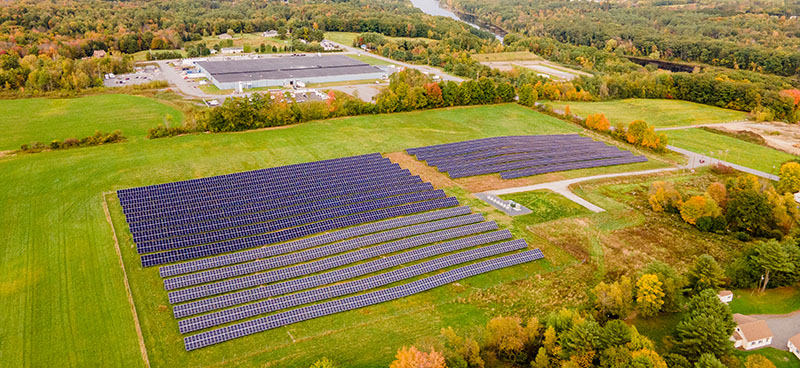News: Northern New England
Posted: August 4, 2009
While we are not completely out of the woods, things are improving and the future looks bright
It's been a rainy, cloudy, dismal spring and early summer here in Maine and even the most optimistic among has been dragged down by the weather. However, in the past week we have experienced our first truly, bright, sunny and warm summer days and are looking forward to more to come. This experience mimics the commercial real estate market over the first half of 2009. As for the bulk of that period, there really has not been much to be too happy about. However, just like the sun that recently came out, we are now seeing glimmers of hope on the commercial real estate horizon here in Maine. The phones are starting to ring again. People are actually calling in on our signs. Office and warehouse users are coming back into the market though retail remains slow.
One trend that has been at the leading edge of this uptick in activity is the "blend and extend" activity generated by savvy tenants with the assistance of experienced brokers. The blend and extend scenario can perhaps best be illustrated by relaying one such example which I was recently involved in. I was hired by a large multi-location office tenant to assist them in evaluating a number of existing leases for various locations, one of which was a 60,000 s/f single-tenant office building lease. The tenant had roughly two years remaining on their lease term with an option to renew for another 10-year term at a predetermined rate. The option renewal rate was above market and not attractive to the tenant. Also, their forecast was such that they would not need the entire 60,000 s/f going forward and could probably consolidate their operations into 45-50,000 s/f of space. We looked at the market for alternatives, identified several possibilities and then narrowed it down to two specific properties. Armed with the knowledge of the costs of the tenant's alternatives at reduced size occupancy, we then went to the existing landlord with a proposal to renew for ten years now (two years early) but at an annual lease cost roughly equivalent to that available in the smaller alternatives we had located. This represented a radical reduction from the above-market option exercise lease rate and was also a significant reduction from the current lease rate. However, by agreeing to this structure the landlord was able to secure the future of the property for the next 12 years, avoid the risk and downtime involved in locating a new tenant two years from now, eliminate the likely costs involved in tenant improvements for a new tenant or tenants if the space were to be subdivided, and, most importantly, was able to position the building for long-term financing. The tenant was able to reduce their current and future costs and fix them at a predetermined level for the next 12 years. It was a "win-win" for all concerned. As the tenant representative, we were compensated through a commission on this newly negotiated transaction which the landlord was happy to pay in order to secure the long-term future of his asset.
Tenant retention is the name of the game these days for landlords. The best tenant you will ever have may be the tenant you have now. Smart tenants are initiating the "blend and extend" technique described above and some are simply approaching their landlords for rent reductions without any promise for future extension of the lease term based on the premise that "times are tough and I need a break in order to survive." These requests present landlords with an interesting dilemma. If, as a landlord, you knew for sure that this tenant's business would fail and you would lose them as a tenant if you did not give them a rent reduction, you would be well advised to consider some level of rent reduction as something is better than nothing and nothing is what you will have if the tenant's business fails. However, if you also knew for sure that the tenant's business will in fact survive and they will continue to pay the contract rent if you do not go along with a rent reduction, then you would have no real incentive to acquiesce to their request. Therefore, a landlord should ask to see the tenant's financials and have a better understanding of the tenant's business situation when considering such a request in rent reduction. Note this subtle but important nuance between this scenario and the blend and extend scenario: If the tenant is willing to extend their term in return for some level of rent reduction, that is value bargained for between the landlord and the tenant. However, a straight reduction in current rent with no extension of term is clearly a "gift" from the landlord to the tenant but it may be a gift worth giving if losing the tenant altogether is a real possibility.
Overall, we have not seen significant reductions in asking rents, but the lease rates on actual done deals do show a decline. Smart landlords know that in this market, with limited demand and significant supply, price matters. Every tenant is looking to reduce operating costs as much as possible and with occupancy costs typically being the second biggest expense line item behind personnel, it is an area which receives a great deal of scrutiny. More than ever, tenants have several options to choose from and landlords who step up with aggressive lease proposals are the winners in this market.
While I cannot speak for the status of the lending climate nationwide, certainly here in Maine, commercial real estate has really not been substantially affected by the "credit crunch." Most of the local community banks have plenty of money to lend and rates remain at historical lows. There are, however, some new rules to the game involving substantial equity requirements, but the money is there. While those prospective buyers who cannot meet those equity requirements are simply not players any longer, we have not seen a lack of available financing to be much of an impediment to our business.
Overall, our market fundamentals are good. There is not an excess of supply and while demand has been somewhat limited, there has certainly not been a "crash" in the market. We are not seeing the foreclosures and other market turmoil which we saw in the recession of the late 1980s and early 1990s as the lenders simply have not, to-date, toughened up on their borrowers. So long as the borrower is making their loan payments as scheduled, the banks do not seem inclined to foreclose on them even if the required loan to value and/or debt service coverage ratios are askew. During the last major real estate crash, the federal government forced lenders to foreclose on borrowers whose "numbers did not add up", even if they were current on loan payments, and this flooded the market with properties. While many in our industry would welcome those buying opportunities once again, the fact that this has not occurred this time around has propped up market pricing. It's not over yet and, in particular, those properties financed through securitized loans may face substantial refinancing difficulties when those loans come due. A large "bulge" of those maturities is coming through the system in the next 6 to 24 months. This could drive some buying opportunities but here in Maine the number of properties financed through the securitized markets is relatively small and consists of mostly larger, institutional grade properties. However, with the potential for future distressed property sales looming, many investors are sitting on the sidelines waiting for that to occur before they invest their funds. This is driving a gap between sellers' price expectations/requirements and the prices buyers are willing to pay and this factor has been the single largest impediment to a robust commercial real estate market over the past year.
So about those sunny days, what are the bright spots? The market is starting to move again. Consumer confidence is up. Leading indicators say that the recession is actually over and we are climbing out of the doldrums we have been in. You can feel it on the street, you can feel it in discussions with business owners and operators, and you hear it in discussions with real estate investors. In fact, many investors are starting to feel that now is the time to make their move as the expected wave of foreclosures very well may not occur and, as the economy improves, pricing levels will once again go up. Housing starts nationwide are up significantly and the housing industry drives our economy like virtually no other sector. Many commercial tenants, property owners and investors are making their move or contemplating doing so in the very near future. While we are clearly not completely out of the woods (in fact as I write this article it's raining, again) things are clearly improving and the future does look bright for the first time in several months. We are on the way out of this slump. Look forward to brighter days.
Tony McDonald, CCIM, SIOR, is a partner with CBRE|The Boulos Company, Portland.
MORE FROM Northern New England
Northern New England
While many Realtors will tell you what you need to do in order to sell your residential property at the highest price (clean out the junk, update bathrooms and kitchens, paint, etc.) most people don’t get easy to follow guidance on what to do to help your commercial real estate sale. Other than that advice that I












